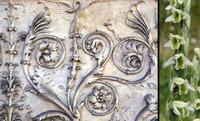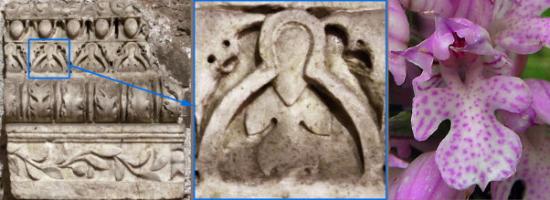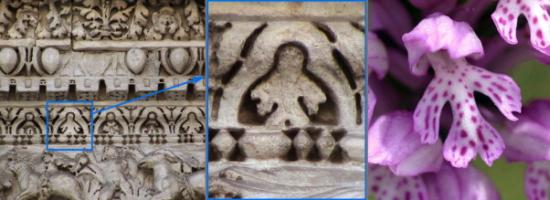David Malakoff
Source - http://news.sciencemag.org/sciencenow/2012/10/caesar-the-orchid-chief.html?ref=hp

Flower power. The Ara Pacis, an altar erected in Rome by the emperor Augustus in 9 B.C.E., includes one of the earliest documented depictions of an orchid (inset) in Western art. Credit: Wikimedia Commons; Bernd Haynold/Wikimedia Commons
Turns out the early Romans were wild about orchids. A careful study of ancient artifacts in Italy has pushed back the earliest documented appearance of the showy and highly symbolic flowers in Western art from Renaissance to Roman times. In fact, the researchers say, the orchid's popularity in public art appeared to wilt with the arrival of Christianity, perhaps because of its associations with sexuality.
The fanciful shapes and bright colors of orchids have long made them popular with flower fanciers, and today they support a multibillion-dollar global trade. The flowers also have a symbolic value that spans many cultures due to their resemblance to both male and female sexual organs; the flower's scientific name—Orchis—derives from a Greek word for testicles. But while the biology and ecology of orchids has gotten plenty of attention from researchers, there are few studies of its "phytoiconography," or how the flower has been used symbolically in art.
A few years ago, botanist Giulia Caneva of the University of Rome (Roma Tre) set out to change that. Working with several graduate students, she began assembling a database of Italian artifacts, including paintings, textiles, and stone carvings of subjects including vegetation. Then, the team began the painstaking process of trying to identify the real plants the artists had copied.
One surprise was that depictions of Italian orchids—there are about 100 species in all—showed up much earlier than expected. Although scholars had spotted the flowers in paintings from the 1400s, Caneva's team discovered that stone carvers were reproducing orchids as early as 46 B.C.E., when Julius Caesar erected the Temple of Venus Genetrix in Rome. And at least three orchids appear among dozens of other plants on the Ara Pacis, a massive stone altar erected by the emperor Augustus in 9 B.C.E., Caneva and colleagues reported last week in the Journal of Cultural Heritage. Artists probably chose the flowers to help emphasize the altar's theme of civic rebirth, fertility, and prosperity following a long period of conflict, Caneva says.
But orchids and other plants begin to fade from public art as Christianity began to gain influence in the 3rd and 4th centuries, she notes. "My idea is that they are eliminating pagan symbols, and [those] that are related to sexuality," she says. With the arrival of the Renaissance, however, orchids blossom anew in art, "but this time mostly as a symbol of beauty and elegance."
The new study is a reminder of "just how much history is tied up with this flower. … It shows up in all kinds of places you might not expect it," says Kristin Nicole Edrington, a jewelry specialist in Alexandria, Virginia. She recently completed a master's dissertation at the Corcoran College of Art + Design in Washington, D.C., that examined the rise of orchid imagery in high-end jewelry made in the late 19th and early 20th centuries. The discovery that Roman artists also favored the flower, she says, just confirms that "orchid mania is nothing new, and was such a big thing even back in the day."
Orchids in the Roman culture and iconography: Evidence for the first representations in antiquity
Alma Kumbaric, , Valentina Savo , Giulia Caneva
Abstract

Parts of Roman cornices of the Mecenate's Auditorium Museum (left); detail of the orchid flower in the frieze (in the middle); Orchis tridentata Scop. in the wild (on the right).
Orchids have fascinated humans since ancient times. Not only the particular morphology of their flowers and hypogean organs, but also their reproductive biology have inspired myths, legends and popular traditions in many cultures, all around the world. Despite these facts, their representations on ancient artefacts have never been described in the scientific literature. No clear data exist for Eastern culture, and in Western countries, the first certain representations of orchids in art date back to the XV-XVI century CE. This paper documents different identifications of orchids on Roman monuments changing the common belief that these plants first appeared in art more recently. Floral elements of Cephalanthera spp., Spiranthes spiralis (L.) Chevall, of Orchis tridentata Scop., and of other orchids were observed in different architectonical elements (cornices and ceilings) throughout the Roman period, and in the external frieze of the Ara Pacis monument (I century CE). These representations seem to refer to a symbolism of fertility and sexuality, and their absence in medieval time can be explained only considering religion influences.

Detail of the Roman cornice of the Crescenzi House (left); detail of the orchid flower in the frieze (in the middle); Orchis tridentata Scop. in the wild (on the right).
http://www.sciencedirect.com/science/article/pii/S129620741200146X